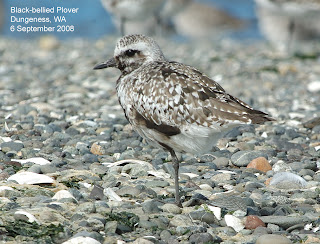We often think of vultures as big, ominous-looking birds
sitting around the carcass of a lion-killed wildebeest in Kenya or lined up on
rooftops next to a garbage dump in South America. But we have our own carrion-eating
vulture in the Pacific Northwest, the Turkey Vulture (Cathartes aura).
Turkey Vultures occur throughout the tropical and temperate
parts of the New World, from southern Canada to Tierra del Fuego. Those at the
northern end of the range, in Canada and northern US, are migratory. Tremendous
numbers of Turkey Vultures migrate through Mexico and Central America. The
vulture migration over Panama in October has almost reached the status of a
tourist attraction, as the birds wheel and climb above the high-rise towers of
Panama City in the fall, along with Swainson’s and Broad-winged Hawks.
They return to Washington from their tropical wintering
grounds in late March and April to occupy nest sites on cliff ledges or in
broken-off hollow trees or other dark recesses, usually in remote areas well
away from human disturbance. They lay 2 eggs that they incubate for about 40
days. The young remain in and near the nest for up to three months after
hatching. Oddly, although commonly seen in the air, they are almost never seen
at road kill, very different from the situation farther south.
These vultures are very often seen early in the morning perched with wings outspread, apparently to dry them out. Why this is so common in vultures and doesn't occur so much in other large soaring birds may be a mystery we never solve.
Turkey Vultures fly with their wings held up in a dihedral
angle, which it turns out adds stability in turbulent air. They often fly close
to the ground, so this is of great importance. As a wind current hits one side,
that wing tilts up and the other down. As it tilts down, it approaches the
horizontal, where lift is maximal, and that stabilizes it. Watch a vulture in
windy conditions and see how it tilts from side to side.
Unlike most other vultures, Turkey Vultures have a well-developed
olfactory sense. Field experiments have shown that they can find something as
small as a dead mouse by its smell, even under a closed forest canopy. Watch a
Turkey Vulture quartering on the wind, going back and forth as first one
nostril and then the other picks up the smell of a carcass from upwind. By
going back and forth as the smell gets stronger and weaker, they eventually
home in on the spot.
At lower latitudes, where Black Vultures are abundant, they
may use Turkey Vultures as their carcass finders, watching individuals of the
other species and following them to the ground. The Blacks are also watching
each other, so the stimulus from a descending bird spreads outward, probably
for quite a distance. Blacks dominate Turkeys, so the Turkeys must be quick to
take advantage of a “fresh” meal. In the forested tropics, the much rarer big
white King Vultures may finally appear and scatter all the lesser birds.
Turkey Vultures have actually increased in the PNW in recent
years, for reasons unknown. Are there more dead animals now? Are they being
more successful on their wintering grounds? Were they reduced by DDT like so
many other raptors and are still recovering? In any case, they are masters of
the air and a pleasure to see in the sky.
Dennis Paulson





.jpg)
4.jpg)
2.jpg)
1.jpg)




